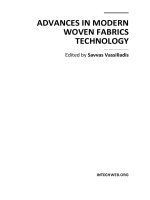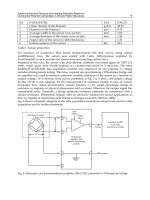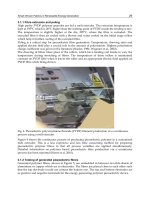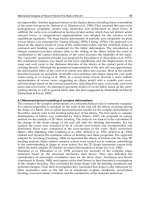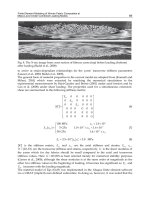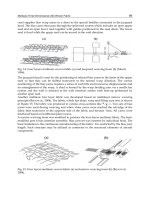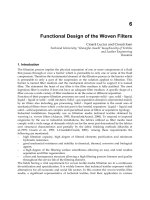Advances in Modern Woven Fabrics Technology Part 13 pdf
Bạn đang xem bản rút gọn của tài liệu. Xem và tải ngay bản đầy đủ của tài liệu tại đây (1 MB, 12 trang )
Liquid Transport in Nylon 6.6. Woven Fabrics Used
for Outdoor Performance Clothing
229
Fig. 18. Actual Liquid Advance Sample S1F-Washed Vs. Unwashed Fabrics
Fig. 19. Wicking Test Sample S1F- Unwashed Vs Washed Fabrics
Advances in Modern Woven Fabrics Technology
230
Fig. 20. Actual Liquid Advance Sample S1F -Washed Vs Unwashed Fabrics
Fig. 21. Wicking Tests Sample S2F-Washed Vs. Unwashed Fabrics
Liquid Transport in Nylon 6.6. Woven Fabrics Used
for Outdoor Performance Clothing
231
Fig. 22. Actual Liquid Advance Sample S2F -Washed Vs Unwashed Fabrics
Fig. 23. Wicking Tests Sample S2F-Washed Vs. Unwashed Fabrics
Advances in Modern Woven Fabrics Technology
232
Fig. 24. Actual Liquid Advance Sample S2F -Washed Vs Unwashed Fabrics
7. Consistency with Washburn’s equation: Fabrics
The general laws that govern capillary flow in simple cylindrical tubes as expounded by
Washburn’s well-known equation shown in (1) is frequently used to study liquid transport
in textile substrates as information obtained from such treatment is useful for the qualitative
characterization of the process of liquid transport
13
in complex textile structures.
1
2
hCt (1)
Where
h is the distance travelled by a liquid in time t and C is proportional to the set of
factors
1
2
cosr
(2)
Where γ = liquid surface tension, η = viscosity of the wicking liquid, θ = contact angle of the
liquid against the fibre substance and
r = capillary radius.
Several researchers have modified the expression as a basis for calculation of liquid
movement in textiles. Laughlin
19
modified the equation into a general form
k
hct (3)
Taking logarithms of both sides of this equation gives
ln ln lnhkt c (4)
Liquid Transport in Nylon 6.6. Woven Fabrics Used
for Outdoor Performance Clothing
233
This equation has the form of a straight line.
Plots of the logarithm of the height of rise h and the logarithm of the duration of time
t in
Figures 19 to 26 have a form of a straight line indicating that the wetting liquid follows
diffusive capillary dynamics.
20
The tabulation of the k values of fabric S2F made from flat
continuous filament yarns given in Table 8 ranged from 0.1487-0.2925 and for fabric S1F
composed of continuous filament warp and textured filament weft yarns the range was
from 0.3312-0.4427. In all the cases the time exponents k were less than Washburn’s
predicted time exponent of 0.5. which was attributed to the non-uniformity of the weft
filament arrangement and the simultaneously occurrence of wetting, wicking, liquid
dispersion and evaporation. Data points deviating from the trend line (Figures 25-32) mostly
towards the end is an indication that with a significantly volatile liquid like water,
evaporation from the wet surface of the fabric strip can compete with capillary process that
advances the liquid.
12
Sample Description Vertical wicking
k-value
Horizontal wicking
k-value
S1F-warp
direction
Unwashed
Washed
0.4427
0.3262
0.3255
0.3478
S1F-weft direction Unwashed
Washed
0.3312
0.3277
0.4217
0.3773
S2F-warp
direction
Unwashed
Washed
0.1487
0.2051
0.1725
0.1965
S2F-weft direction Unwashed
Washed
0.2179
0.2133
0.2925
0.2125
Table 8. Strip Wicking Test k-values
Fig. 25. Vertical Wicking Sample S1F-Unwashed Fabrics
Advances in Modern Woven Fabrics Technology
234
Fig. 26. Horizontal Wicking of Sample S1F -Unwashed Fabrics
Fig. 27. Vertical Wicking Samples S2F-Unwashed Fabrics
Liquid Transport in Nylon 6.6. Woven Fabrics Used
for Outdoor Performance Clothing
235
Fig. 28. Horizontal Wicking Sample S2F-Unwashed Fabrics
Fig. 29. Vertical Wicking Sample S1F-Washed Fabrics
Advances in Modern Woven Fabrics Technology
236
Fig. 30. Horizontal Wicking Sample S1F-Washed Fabrics
Liquid Transport in Nylon 6.6. Woven Fabrics Used
for Outdoor Performance Clothing
237
Fig. 31. Vertical Wicking Sample S2F-Washed Fabrics
Advances in Modern Woven Fabrics Technology
238
Fig. 32. Horizontal Wicking Sample S2F-Washed Fabric
Liquid Transport in Nylon 6.6. Woven Fabrics Used
for Outdoor Performance Clothing
239
8. Conclusion
Miller and Tyomkin
21
state that when a porous material such as a fabric is placed in contact
with a liquid, spontaneous uptake of liquid may occur. Law
9
observed that if the wicking
distance is plotted against time, the graph is expected to have an initial rapid rate of change
which decreases subsequently because water is first sucked into wider capillary channels by
the action of surface tension. As the wicking process proceeds further, the total viscous
resistance to the flow increases and the rate of flow decreases. In the case of the vertical strip
test, the height and the mass of the water absorbed in the sample strip will gradually reach a
quasi-equilibrium state when they are balanced by the hydrostatic head of water. In the case
of the horizontal strip test, if the supply water is unlimited, the rate of penetration will
gradually become constant.
9
In thick fabrics vertical wicking would continue with little
effect of evaporation until a quasi-equilibrium state is reached when the wicking level in the
fabric is balanced by gravity.
10
In this work vertical and horizontal wicking of samples S1F and S2F did not continue
indefinitely indicating that due to the combination of low fabric weight and thickness the
maximum wicking height was not only influenced by gravity but also by evaporation. The
rate of evaporation of liquid therefore determined the equilibrium point for both vertical
and horizontal wicking of samples S1F and S2F indicating good properties required for
eliminating perspiration discomfort which would cause fabric wetness
with resulting
problems of freezing in winter or clamminess
22
in summer. In most cases, the leading front
of the water rise observed at the end of each test period felt dry to the touch which can be
attributed to the rapid liquid evaporation of the fabrics.
In textured yarns, the manner in which the liquid is transported through the fabric is
determined by the minute loops or coils that characterize air –textured yarns which act as
pores that vary in shape and distribution and may or may not be interconnected. Hsieh
6
noted that pore variation and distribution leads to preferential liquid movement towards
smaller pores, resulting in partial draining of previously filled pores in the fibrous structure.
In all cases studied in this work, tests showed that there is a good linear relationship
between the logarithm of the wicked liquid ( l ) and the logarithm of the wicking time (
t )
indicating that the wetting liquid follows diffusive capillary dynamics
20
even though for
sample S1F in most cases the exponential values were high compared to sample S2F due to
evaporation from the parallel packed filaments of the yarn structures.
The high
k values of fabrics containing textured weft yarns indicate the characteristics of a
non-homogenous capillary system where wicking is a discontinuous process due to the
irregular capillary spaces of varying dimensions.
11
Rapid wicking is retarded by the
‘absorber’ textured weft yarns which are more bulky and act as temporary liquid reservoirs
as all the voids are filled up. On the other hand, the inter-filament wicking rate is increased
once the liquid is transferred to the flat ‘runner’continuous filament warp yarn due to
capillary sorption
11
resulting in spiked wicking behaviour observed.
Wicking is also affected by fabric construction. Fabric sample S2F wicked more rapid in the
warp than in the weft direction due to the high density of ends in the fabric. If the filament
packing in the yarn is assumed to be an idealized or closely packed assembly
23
there will be
more capillaries in the warp than in the weft direction due to the distribution in the number
of ends and picks.
Outdoor active wear such as jackets are infrequently washed and research
24
results have
shown that a standard 5 washes of vests used for mountaineering resulted in a significant
Advances in Modern Woven Fabrics Technology
240
increase in their wicking performance. Even though a spin finish was applied to fabrics S1F
and S2F during finishing to give surface properties which can allow liquid flow, the
durability of the spin finish to washing was insignificant since laundering of fabrics resulted
in a significant increase in their wicking performance. Washing therefore did not lead to the
collapse of the capillary system of the fabric but results in the re-arrangement of the
capillaries between filaments due to the washing liquid movements and the relaxation of the
textile structure during drying.
24
9. References
[1] Barnes J.C and Holcombe B.V., Textile Res. J., 66(12), 777-786, 1996
[2] Brownless N.J., Anand S.C., Holmes D.A. and Rowe T., J. Text. Inst., 87 Part 1, No.1, 172-
182, 1996.
[3] Brownless N.J., Anand S.C., Holmes D.A. and Rowe T., Textile Asia, August 1996, 77-80.
[4] Slater K.,Comfort Properties of Textiles, Textile Progress, Volume 9, Number 4, 1-91,
Textile Institute 1977.
[5] Yoon H.N. and Buckley A., Text. Res. J., 54, 289-298, 1984.
[6] You-Lo Hsieh, Text. Res. J., 65(5), 299-307, 1995
[7] Brownless N.J., S.c. Anand, D.A. Holmes and T. Rowe, World Sports Activewear,
Volume 2, No.2, 36-38, 1996
[8] A.B. Nyoni and D. Brook, J. Text. Inst., Vol.97, No.2, 2006, 119-128.
[9] Law Y.M.M., Ph.D Thesis, University of Leeds, 1988.
[10] Zhuang Q., Ph.D. Thesis, University of Leeds, 2001.
[11] Kissa E., Text. Res. J., 66 (10), 660-668, 1998
[12] Miller B., International Nonwovens Journal, Volume 9, No.1, Spring 2000.
[13] Pronoy K. Chatterjee and Hien V. Nguyen., Mechanism of Liquid Flow and Structure
Property Relationships., Absorbency, Chapter II., Edited by Pronoy K. Chatterjee,
Elsevier Scientific Publishers; Amsterdam; New York, NY: 1985.
[14] Harnett P.R. and Mehta P.N., Tex. Res. J., 54, 471-478, 1984
[15] A.B Nyoni., (2003), PhD Thesis, University of Leeds.
[16] Hepburn C.D., PhD. Thesis, University of Leeds 1998
[17] Leijala A and Hautojarvi. J, Text. Res. J.,68(3), 193-202, 1998.
[18] Blyth G.T., Ph.D. Thesis, University of Leeds, 1984.
[19] Laughlin R.D. and Davies J.E., Text. Res. J., 31,904-910, 1961.
[20] Anne Perwuelz, Mthilde Casetta and Claude Caze, Polymer Testing, Volume 20, Issue
5, 553-561, 2001.
[21] Miller B. and Tyomkin. I., Text. Res. J., Volume 54, 706-712, Nov. 1984
[22] Rees W.H., Text. Month, 59-61, August 1969
[23] Hearle J.W.S., Grosberg P., and Backer S., Structural Mechanics of Fibres, Yarns, and
Fabrics. Volume 1, 1969, John Wiley; New York, NY, USA.
[24] A.B Nyoni and D.Brook, Textile Research Journal ,Vol.80(8), 2010, 720-725.



